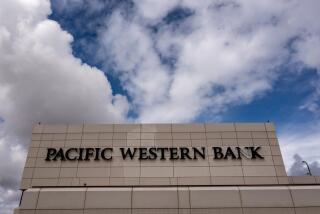Banks at the Barricades : Finance: The industry is being assaulted on all sides. The result is that the number of domestic institutions has dropped dramatically--and the trend may continue.
- Share via
U.S. banks are under siege at home and abroad in what is resembling an Alamo-like battle.
American Telephone & Telegraph in just six months has become the nation’s sixth-largest issuer of MasterCard and Visa credit cards. Sears, Roebuck & Co. has issued nearly 36 million Discover cards in the United States, more credit cards than any bank has ever issued domestically. General Motors, through a Utah affiliate, is offering government-insured certificates of deposit, just like a bank.
Even if you haven’t driven a Ford lately, you may well have banked with the company. The nation’s second-largest auto maker also is the nation’s second-largest bank--if you stretch the definition. The $119 billion in assets in Ford’s savings and loan, car financing, leasing and credit card operations as of June 30 would rank second in size as a bank only to Citicorp.
Competition is even tougher overseas. Some 41 cents of every dollar held by the world’s 100 largest banks were in Japanese institutions at the end of last year, double the amount 15 years ago. By comparison, only 11 cents of every dollar is in a U.S. bank, one-third of what they held in 1970.
U.S. banks once were the world’s largest. Now only Citicorp makes the world’s top 20 in size, and only four domestic banks make the top 50.
“The issue of competitiveness, broadly defined, is becoming an increasingly serious problem both in the U.S. and for U.S. banks abroad,” said BankAmerica Corp. Vice Chairman Lewis W. Coleman. “It’s a serious, big-picture problem.”
The assaults on U.S. banking couldn’t come at a worse time. Hurt by bad foreign loans, growing problems with real estate borrowers and shaky lending to finance corporate buyouts, many of the largest banks have little room for error. Last week, U.S. Comptroller of the Currency Robert L. Clarke issued an ominous note when he predicted that banks, especially on the East Coast, will experience even more real estate woes.
Even a Federal Reserve Board decision Thursday allowing the limited offering of securities by New York banking giant J. P. Morgan & Co. is not expected to provide immediate help in making banks more competitive. Few banks are as strong as Morgan, so most, for now, will not be able to take immediate advantage of expanded powers. Besides, the securities business itself is in a severe slump.
Many large banks are skating on thin layers of capital, the financial safety nets that they maintain to absorb losses. With a recession lurking, profits are expected to be weak this year.
No one is saying that banks are in a permanent decline. But the combination of their growing problems and increased competition at home and overseas doesn’t bode well. Some 1,000 banks have disappeared the past two years through mergers and buyouts, and an additional 427 have failed. The 192 banks that received charters last year represented the lowest number in 10 years.
Banking executives believe that a shakeout of the weakest banks is needed to help the industry recover, with the list of survivors dominated by regional banks with strong retail branch networks.
In the next five years, some believe, as many as 3,000 to 5,000 banks will disappear through failures or mergers from among the 12,700 institutions operating at the end of 1989. Bank executives expect one or more of the nation’s huge “money center” institutions to disappear through a merger because of the pressure to build capital.
One of the most troubled money center banks is Chase Manhattan Corp. The nation’s second-largest banking firm said Friday that it will have to slash costs by $300 million a year and that it expects to post a $625-million loss in its third quarter.
Banks’ long-term problems can be broadly defined in three areas.
First, too many banks are chasing too few good lending opportunities. Second, an array of regulations, some dating to the 1920s, make U.S. banking inefficient and less competitive. And third, the cost of raising badly needed capital is expensive for banks, relative to what it costs their non-bank competitors and foreign institutions.
This doesn’t mean that all banks are doing poorly. Some regional banks are doing well, mainly because they have maintained strong balance sheets, scrutinized borrowers closely and developed franchises aimed at consumer borrowers.
Especially strong are such regional banks as Banc One in Ohio, First Wachovia and NCNB Corp. in North Carolina, NBD Bancorp Inc. in Detroit and CoreStates Financial Corp. in Philadelphia. In California, Wells Fargo & Co. and BankAmerica, both in San Francisco, and Los Angeles-based Security Pacific Corp. have outperformed most banks nationwide, although concerns are rising about their vulnerability to a softening real estate market and deteriorating corporate buyout loans.
Despite the regional bright spots, overall nervousness is increasing, however.
Alarms are going off in Washington--where politicians are seething from the thrift debacle--as concerns grow that the nation’s deposit insurance fund may not be big enough to protect taxpayers should some of the nation’s weaker banks fail. Rating agencies are regularly downgrading banks. Investors shun bank stocks, making it harder for institutions to raise much needed capital.
The smaller number of good lending opportunities can be blamed for some of the banking industry’s malaise. Corporate customers, once the mainstay of bank borrowers, increasingly bypass banks by issuing IOUs in the form of commercial paper to raise money. Four of 10 people who buy a General Motors car or truck this year will finance it through GM.
As a result, banks searching for lending opportunities have been forced to make riskier loans and give borrowers easier terms.
“Banks have been precluded in their ability to expand geographically and in terms of products. As certain markets have been taken away, they’ve gone to other markets,” said Security Pacific Chief Executive Robert H. Smith.
In recent years, much of that opportunity was in real estate. Many believe that the reason so many banks went into it is in part because of the lack of opportunities elsewhere.
Also to make money, banks have increasingly turned to consumer lending--such as home loans, home equity loans and credit cards--which can be highly profitable.
But some worry that there are already too many banking and non-banking players in those businesses, inviting trouble by making home equity loans or credit cards too easy to get. A nationwide recession and further job layoffs would not only slow consumer borrowing but also increase problem consumer loans.
An overabundance of domestic banks has made the nation’s banking system inefficient, weakening U.S. banks as global competitors. Foreign institutions are not burdened with the same splintered system.
There are 53 banks per 1 million people in the United States. That compares to 11 per million in Great Britain, five per million in West Germany, three per million in Canada and one per million in Japan. Indeed, if the United States had the same number of banks per capita as Europe does, there would be only 700 banking firms, instead of the 10,000 now that own the nation’s nearly 13,000 banks.
Needless to say, the global ambitions of many U.S. banks have been shelved. Few American banks are in a position, for example, to take advantage of the financing boom expected in Europe after its economic integration in 1992. They have yielded the market to such European giants as Germany’s Deutsche Bank. Making it even more difficult for U.S. banks to penetrate Europe is the fact that many institutions there have ownership ties with corporations.
“To compete in Germany with German banks would be impossible,” Security Pacific’s Smith said.
Critics of the nation’s banking policies say laws and regulations discourage the squeezing out of weak banks from the industry. Some of that stems from the government’s decision to save Chicago-based Continental Illinois in 1984 and the clear policy of federal regulators that some banks are too big to allow to fail.
“We not only protect mediocrity, we then turn around and insure it with taxpayers’ money,” BankAmerica’s Coleman said.
Regulations also promote inefficiencies as well. State and federal laws, some of which date to the 1920s, make it unwieldy to cross state lines and restrict the kind of products that can be offered in branches.
Banks are increasingly being allowed to cross state lines, such as through the easing of California’s interstate banking laws next year. In theory, this allows a bank to spread its risk across different geographic areas and absorb the shocks of regional economic downturns.
But state and federal laws, some of which predate the Great Depression, require bank holding companies to set up separate banks in each state, a highly inefficient process as opposed to merely opening branches of the same bank in different states. They must have separate boards of directors and in many cases have no choice but to operate separate computer systems from their main ones.
First Interstate Bancorp in Los Angeles, which has the nation’s largest interstate banking network, has 232 directors in the 13 states where it owns banks, not counting the parent company’s 16 directors. Thirty-three of those directors are in New Mexico, where First Interstate must maintain four separate boards for each bank it owns there.
Banks are also restricted in what they can sell at branches. They ideally would like to offer mutual funds, insurance, stocks and real estate and other financial products, becoming more of a one-stop financial services center.
Supporters of banking restrictions have argued over the years that relaxing the rules will concentrate economic power in the hands of fewer institutions. Offering products such as insurance and securities could prove risky for banks, they argue. Interstate banking restrictions helped guarantee that local savings stayed close to home, they add.
But bankers and regulators argue that the financial system is now a global one and that the competitor now is as much a bank in Tokyo or London as it is the bank across the street. Some 25% of U.S. banking assets are held by foreign competitors, who operate under far fewer restrictions in their home countries than U.S. banks do here.
“Our banks have one hand tied behind their backs, and we’ve put them into the ring with heavyweights,” said L. William Seidman, chairman of the Federal Deposit Insurance Corp.
Unlike the case in Europe and Japan, U.S. regulations have set up something of a one-way street in the relationship between banking and commerce. In Europe and Japan, banks may own a chunk of a company with which they do business. In the United States, that is prohibited. But companies such as AT&T;, GM and Ford can easily enter banking activities.
“Commerce can get into banking, but banking can’t get into commerce,” said John Spiegel, chief financial officer of SunTrust Banks Inc. in Atlanta.
Banking reform is expected to be one of the top legislative issues next year, when the Bush Administration proposes a series of changes. The package is expected to include new investment powers as a way to help domestic banks compete with foreign banks.
So what is ahead?
BankAmerica’s Coleman sees the industry organized later this decade into two categories: a handful of large banks formed through mergers, and a lot of small local banks. Security Pacific’s Smith agrees that big mergers are ahead but contends that it may take time.
“The natural forces of egos probably won’t let it take place rapidly. What it says is that it has to be driven by economic factors--the ability to compete. Once someone does it, and it becomes commonplace, others will do it,” Smith said.
Some developments are emerging that may make banks more competitive.
The Fed decision to give J. P. Morgan limited power to underwrite stocks was a major chip in the 57-year-old Glass-Steagall Act, which separates banks from Wall Street. Bankers believe that eventually their institutions will offer regional investment banking services for corporations in their areas. Other powers may follow that would allow banks broad access to such areas as mutual funds, insurance and residential real estate sales, transforming the conventional bank branch into more of a financial services center.
Japanese banks may also be less of a threat. Those institutions, which count unrealized stock market profits as part of their capital, now have less capital in the wake of the Tokyo market’s decline. As a result, they may rein in their U.S. activities.
Meanwhile, MasterCard and Visa are discussing limiting access to their credit card systems by non-banks.
But the thrift debacle, which is expected to cost taxpayers $500 billion over 30 years, may slow things. Congress may still have enough of a bitter taste in its mouth to resist increasing bank powers, even if they include protections for taxpayers.
“I don’t think the mood is very good. In general, it sounds like deregulation, and deregulation is blamed for the savings and loan mess,” Seidman said.
GROWING NON-BANK COMPETITION
Banks are facing increasing competition from non-bank entities. As an example, the financial services-related assets of the nation’s two largest auto makers would place them among the nation’s five largest banks.
Assets as of Dec. 31, 1989, in billions Security Pacific: $83.9 J.P. Morgan: $90 BankAmerica: $98.8 GM: $103.5** Chase Manhattan: $107.4 Ford: $115* Citicorp: $230.6
* Including car financing, leasing, credit card and First Nationwide Bank operations
** General Motors Acceptance Corp. activities, principally auto and mortgage financing.
More to Read
Inside the business of entertainment
The Wide Shot brings you news, analysis and insights on everything from streaming wars to production — and what it all means for the future.
You may occasionally receive promotional content from the Los Angeles Times.










